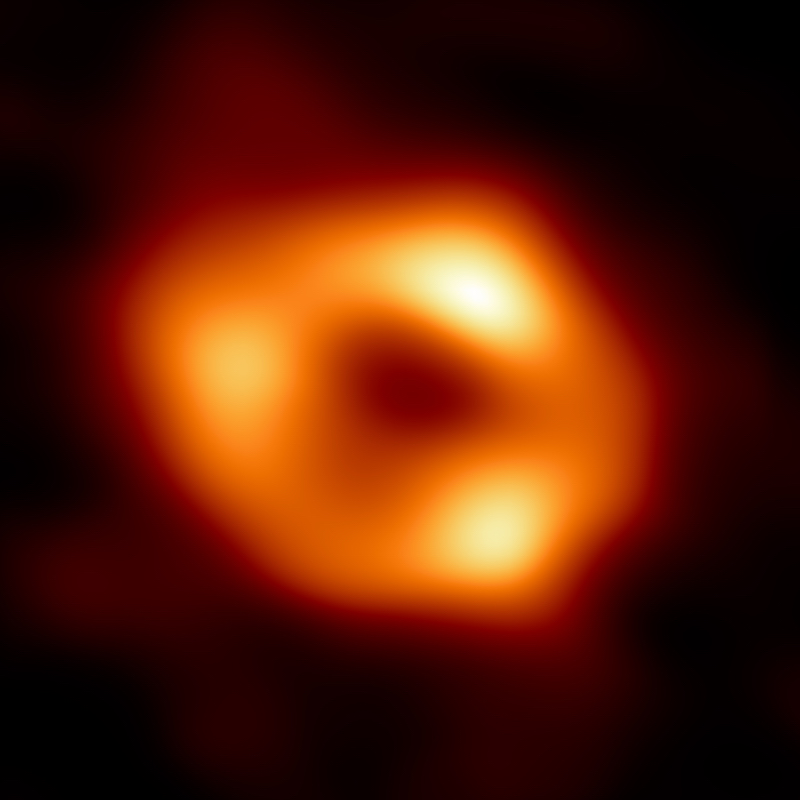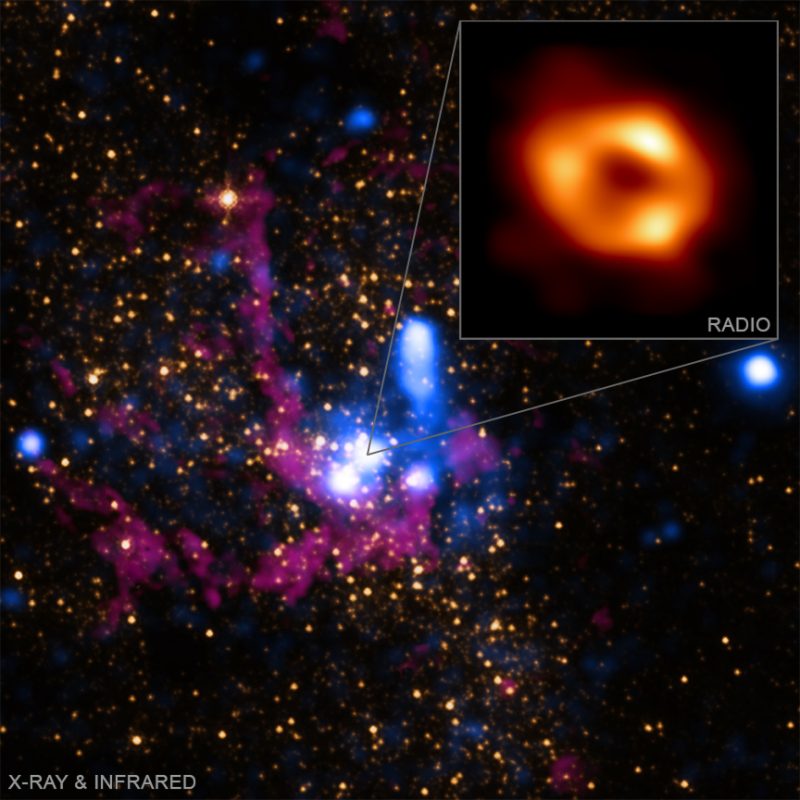
1st direct image of Milky Way’s black hole
At press conferences around the world on May 12, 2022, scientists from the Event Horizon Telescope (EHT) and the European Southern Observatory (ESO) revealed the first-ever direct image of the supermassive black hole at the center of our Milky Way galaxy.
The image shows a glowing ring of gas surrounding a dark area known as the black hole shadow, which measures around 72 million miles (115 million km) across. In other words, if this black hole shadow were in place of our sun, its outer edge would nearly coincide with the orbit of the planet Mercury. Our Milky Way’s supermassive black hole – designated Sagittarius A* or simply Sgr A* (pronounced Sadg A-Star) lies some 26,000 light-years away. The actual black hole is at the center of the shadow but is of course invisible.
This incredible scientific achievement is the result of the work of 300 scientists and engineers from many scientific institutions, working together around the world to create the EHT: a global array of radio telescopes linked together to form a radio telescope the size of the Earth.
? Scientists had previously seen stars orbiting around something invisible, compact & very massive at the centre of the #MilkyWay. This suggested that this object is a black hole & today’s image provides the first direct visual evidence of it. Say hello to #OurBlackHole? pic.twitter.com/UvU4ERkeiU
— ESO (@ESO) May 12, 2022
Sgr A* vs. M87’s black hole
In 2019, the EHT presented the first-ever image of a black hole: the one at the center of the M87 galaxy, some 54 billion light years away. Astronomers call it M87* (pronounced M87-star). M87’s black hole is vastly more massive than the black hole in our Milky Way. The black hole shadow for M87* is slightly larger than the diameter of our entire solar system.
Visually, the image of Sgr A* looks remarkably similar to the one of M87*, with the difference that the glowing ring of gas around Sgr A* is more elliptical: less circular and instead more like a circle someone sat down on. The ring is more unevenly shaped than the near-circular ring around M87*. But the two black holes are hugely different in mass as well as size: M87* has 6 billion times the mass of the sun as against Sgr A*’s 4 million solar masses.
And the rate at which the two black holes consume the material surrounding them is also vastly different: M87* is far more active and consumes the equivalent of 900 Earth-masses per day. Sgr A* in our Milky Way is quieter, consuming just a thousandth of that.
Confirms Einstein, reveals fascinating details
Initial studies of the image have revealed that Sgr A* confirms Einstein’s theory of general relativity to within an error margin of 10%; this was similarly confirmed by the pioneering image of M87*. Black holes, where physical laws are pushed to their limits, are superb testbeds for theories of gravity, magnetism and the behavior of matter in extreme environments. The two images are so similar because black holes are extremely simple objects, affected in the same way by gravity. The image has also revealed that Sgr A* is rotating and is face-on to us; in other words, we are not looking down on its poles. Both the black hole and the ring of gas around it are rotating in the same direction.
The new image was processed from more than 5.5 petabytes of data acquired during the EHT’s observing run in 2017. If you were to print that data out, the stack of paper would reach the moon! It has taken so long to process because of the motion of gas around Sgr A*, which, as seen from the Earth, changes over hours. It’s like trying to photograph a moving car so that the image is not blurred. This has necessitated the development of thousands of computer simulations on powerful supercomputers to assist with extracting the image of the black hole without the blurring effect of the gas.
Since 2017, the EHT has added another three telescopes to the array, which will improve its resolution. The team will now study the new image in depth, while searching for new black hole targets in the sky that can be imaged with this remarkable technology. As one of the scientists at the presentation said, this is just the beginning, the start of a new chapter in astronomers’ quest to understand black holes and the nature of gravity.

Priceless reaction to seeing our Milky Way’s black hole
An astrophysicist’s live reaction to the reveal of the image of the supermassive black hole at the centre of our galaxy, the Milky Way ???@ehtelescope #EventHorizonTelescope pic.twitter.com/NUDy5xZCqG
— Dr Becky Smethurst (@drbecky_) May 12, 2022
Bottom line: Astronomers gave the world the first-ever direct image of our Milky Way’s supermassive black hole on May 12, 2022.
The post Milky Way’s black hole seen at last! first appeared on EarthSky.
0 Commentaires